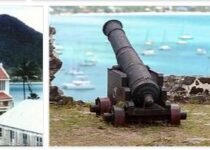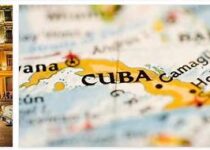Geography of North America
Land
Along the west side of North America lies the Cordillarians, a complex of several parallel mountain ranges, averaging 4,000–5,000 m high. Of the peaks, Mount McKinley in Alaska (6,194 m asl) is highest. The chains are separated by valleys, such as the Central Valley in California, or by plateaus, often with desert conditions, such as the Great Basin, the Colorado Plateau and the Mexican highlands. Volcanoes are common in the western part of the Cordillaries, from the Aleutian archipelago in the north to Panama in the south. Many volcanoes are active. Earthquakes often occur in the Cordillarians, especially in the western part. Glaciers and glacial erosion forms the highest parts of the mountains. Along the south coast of Alaska, glaciers reach as far as the sea. There and along Canada’s west coast there are fjord coasts and large archipelagos.
To the east of the Cordillarians is the northernmost Canadian shield. It is a heavily degraded urban area characterized by glacial erosion and therefore has a large number of lakes. The lowest portions of the shield form Hudson Bay; the highest parts of northeastern Labrador reach about 1,600 m above sea level. The shield continues north in the Arctic archipelago.
To the south, south and west of the Great Lakes, the central lowland, 200–500 m above sea level, spreads. It continues to the west in the Great Plains, plains that gradually rise from about 500 to close to 2,000 meters above sea level. at the Rocky Mountains, the easternmost of the Cordillarians’ chains. To the south, the lowlands turn into a coastal plain. The entire area south of the Shield is drained by the Mississippi River with tributaries.
To the east, the lowlands are bordered by the Appalachians, with elevation ranges up to 1,500 m above sea level. The highest point, Mount Mitchell in the south, reaches 2,037 m above sea level. East of the Appalachians, from New York to Florida and along the Gulf of Mexico to the Yucatán, the coastal plain is spreading. It continues in the lowlands of Cuba, which is the only major plain in the mountainous Great Antilles. The Little Antilles consist of high volcanic islands and low coral and sand islands.
| Country | Important rivers | Largest lake |
| Antigua and Barbuda | – | – |
| Bahamas | there are no rivers | there are no lakes |
| Barbados | – | – |
| Belize | Belize river | – |
| Costa Rica | – | Arenal (artificial) |
| Dominica | – | – |
| Dominican Republic | Yaque del Norte | Lake Enriquillo |
| El Salvador | Río Lempa | Ilopango |
| Grenada | – | Grand Etang |
| Guatemala | Usumacinta, Motagua | Lake Izabalsjön |
| Haiti | Artibonite | Saumâtre |
| Honduras | Patuca River, Choluteca River | – |
| Jamaica | Rio Minho, Black river, Rio Cobre | – |
| Canada | Mackenzie River, St. Lawrence River | Lake Superior (Upper Lake) |
| Cuba | – | – |
| Mexico | Río Brava / Río Grande, Río Usumacinta | Lake Chapala |
| Nicaragua | the border rivers San Juan in the south and Coco in the north and the Rio Grande | Lake Nicaragua |
| Panama | Tuira | – |
| Saint Kitts & Nevis | – | – |
| Saint Lucia | – | – |
| St. Vincent & the Grenadines | – | – |
| Trinidad & Tobago | – | – |
| USA | Missouri-Mississippi | Lake Michigan |
Soil and soils
North America has been built around the Canadian shield, which forms the bedrock in northern and eastern Canada, in the northeastern United States and in most of Greenland. This rock shield consists of rocks formed during the Precambrian (older than about 570 million years), mainly granites and gneisses. The latter have mainly been formed through the transformation of sedimentary and volcanic rocks. The shield began to form through volcanic activity and rock formation (orogenesis) more than 3 900 million years ago. This first orogenesis was followed during the pre-Cambrian by at least five more orogenesis, which meant that new crustaceans were gradually added to the continent. The mountain ranges (orogens) that build up the Canadian shield are today completely degraded.
In the south and west, the shield is covered by flat-lying sedimentary rocks formed from Cambrian to Tertiary (about 570–1.65 million years old). These rocks build up the North American platform, which together with the Canadian shield forms a craton, ie. a stable continent that has not been exposed to mountain range formation or extensive deformation since Proterozoic (more than 570 million years ago). The craton is surrounded by mountain ranges from the phanerozoic (younger than about 570 million years).
During the older Paleozoic period (about 510–409 million years ago), the North American craton (Laurentia) moved on a collision course towards Europe. The collision resulted in the Caledonian orogenesis, a mountain range formation that one can trace in North America from the northern Appalachians via Newfoundland to Greenland’s east coast. A Caledonian mountain range zone also extends along Greenland’s north coast towards Arctic Canada. During the Varian orogenesis in the younger Paleozoic (approximately 375-245 million years ago), the majority of the Appalachians were formed through a collision with northwestern Africa.
Large parts of the mining area formed under the Precambrian were covered under Cambrian to older carbon (about 570–323 million years before today) by warm groundwater, where sandstones, clay shales and limestones were formed. In younger carbon (about 323–290 million years before today), the conditions were alternately marine and continental. Swamp forests had a widespread distribution, resulting in coal-bearing stocks, especially in the central lowlands and west of the Appalachians. During Perm and Triassic (approximately 290–208 million years before today), North America had a warm and dry climate.
Mainland conditions dominated and continental sediments, e.g. red-colored sandstones, deposited. With the exception of parts of the western United States and southwestern Canada, there were also prevailing legal conditions (approximately 208–146 million years before today) mainly in mainland conditions with the provision of continental stock sequences. Some of these stock sequences, in particular the Morrison Formation in the western United States, are known for their rich occurrences of dinosaurs. During Cretaceous (about 146-65 million years before today), the sea again covered large areas, and thick stockpiles were deposited east of the Cordillarians.
Until the beginning of the tertiary (about 60 million years ago), North America was still associated with Europe. The North Atlantic then expanded further and North America continued to move westward, a movement that is still ongoing at a rate of about 1 cm per year. Through North America’s movement westward, a collision with the seabed to the west occurred. From the folded material, a new continental crust was created in the form of the Kordiljärna mountain range along the west side of the continent. This complex of parallel mountain ranges was formed during the alpine orogenesis. Mountain range formation in the area has been going on at least since the end of the Devon (about 370 million years ago), but the true Cordillarians only started to form at the beginning of the tertiary. The mountain range complexes in the west have given rise to large amounts of sediment deposited east of the Cordillaries.
During the early part of the tertiary, up to the middle of the Eocene (about 45 million years ago), North America had land links with Eurasia, and the fauna of the continents was similar. Subsequently, the continents were separated and with the exception of short periods, North America was isolated until the latter part of the Miocene (about 15-10 million years ago). This led to the development of an endemic flora and fauna, which came to mix with the Eurasian at the end of the Miocene epoch.
The quaternary period (the last 1.65 million years) is characterized by repeated cold times. In North America, traces of four major icings have been found. During the maximum extent, the inland ice covered all of Canada and Greenland, the northern parts of the Mississippi Basin and the northeastern United States. Local rock carvings occurred on the mountain ranges in the western United States. The North American fauna has been heavily influenced by immigration waves from Asia over the Quaternary period via the land bridge that was sometimes established over the Bering Strait. The emergence of the Panamanese in the late Tertiary (about 3.5 million years ago) has also been of significance for the fauna’s composition and changes in it.
In northern North America, the soils are moraine and other glacial deposits. Loose soils have a widespread distribution in the central United States, especially in the central lowlands. Other loose deposits can be found, for example, on the coastal plains to the east of the Appalachians, along the Gulf of Mexico and in sinks in the Cordillarians. In other areas, there are mainly weathering soils.
Soils
The northern part of the Arctic climate is covered by leptosols with thin soil cover or cryosols with permanent scab (permafrost). In the temperate zone south of it, pod soles predominate on sandy soils and albelu visols and cambisols (brown soils) on more fine-grained soils. In more humid climatic conditions in this zone, there are organogenic and other water-affected soils (histosols and slides). In the hot and humid area of the southeastern United States, there is an area of heavily weathered soils (acrisols and alisoles).
The prairie in the interior of the continent is dominated by humus-rich steppe moons (chernozems and castanozems) surrounded by deciduous forests with clay enrichment horizons (luvisols). In the desert areas of the southwestern United States and northern Mexico, calcisols are the natural soil. In Texas, there is an area with clay-rich vertical insoles.
In the tropical climate of Central America and the Caribbean, highly weathered soils (nitisols, acrisols and alisols) take over. Volcanic soils (andosoles) are also common in this area.
Natural Resources
North America has significant assets of almost all metals. Deficiency mainly prevails on chrome ore. In the urban areas there are iron, nickel, platinum, gold, silver, copper, tungsten, lead and zinc ores. In addition to the alloys (mainly molybdenum in Colorado), the Cordillaries contain gold and silver (mainly in Mexico) and mercury. Significant lead and zinc resources are found in sedimentary deposits in the Mississippi Basin. The major Antillean assets are cobalt and nickel (Cuba) and bauxite (Jamaica).
Of non-metals, North America has the world’s largest potassium carbonate (potash) reserves in Saskatchewan. Check more on Countryaah.
The energy resources are dominated by uranium (Canada and the US – primarily the Colorado Plateau) and oil (USA and Mexico) and gas (USA). Oil shale (USA) and oil sands (Canada) are other important oil resources. At least 20% of the world’s coal reserves should be found in North America. Hydropower assets are relatively large, mainly in the Cordillarians. Geothermal energy and peat are essential assets.
The freshwater is insufficient in North America’s arid regions, in some agricultural districts and in many metropolitan regions, e.g. Mexico City. Large pipeline systems bring water to California; In dry areas such as Arizona, relative water (fossil groundwater) is exploited. Dirt is a major problem in areas with good water resources.
The tajgan is in North America the most economically important natural vegetation type. Of the temperate grasslands, especially the prairie, little remains in the natural state. The same goes for the prairie’s original bison herds. The Prairie is today North America’s most important agricultural area. The basis for the region’s cultivation lands is loose soil. The area has extensive soil erosion, mainly wind erosion. Alluvial soils are important cultivation lands especially in Central America and the Greater Antilles. The fishing waters off Labrador as well as in the Caribbean, where seafood is significant, are among the world’s most important.



